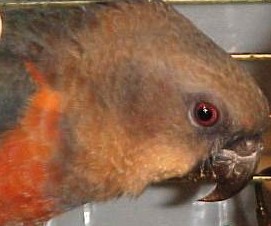Home made, quilted pet carrier covers
Hand raised and tame baby Parrots

|
Small - To Medium-Sized Birds POICEPHALUS Poicephalus are a group of small African parrots best known for their quiet voices and gentle dispositions. Their natural calls are quiet beeps and whistles, and most of the poicephalus can be taught tricks. Many learn to talk, though in a small, mechanical voice. The best known of this group is the Senegal parrot (Poicepbalus senegalus). They are chunky short-tailed parrots colored greenish gray and either bright lemon-yellow or bright orange. In their early years, Senegals need an understanding owner who can teach them the rules of “good” parrot behavior. They can be shy birds, but usually bond well with their owners and make good companions. Meyer’s parrots (P. meyeri) are also good pets among the poicephalus, with different coloration but a similar shape to the Senegal. Less well known, but even sweeter, the brown-headed parrots (P. cryptoxanthus) are more drab in coloration. Their underwings are a bright yellow; everything else about them is gray/green and olive. Another cousin, the red-bellied parrot (P. rufiventris) is dimorphic, meaning that the sexes have different colorations when they become mature. Jardine’s parrots (P. gulielmi) are larger and more expensive than their smaller, squat cousins. Jardine’s are green birds with feathers edged in black and bright orange trim on their heads and wings. Poicephalus range in initial cost from $350 to $600 dollars or more. They need to live in parrot cages, with sturdy bars but small bar spacing. The larger their cage the better, as they enjoy playing and frolicking. Poicephalus enjoy a playgym and access to swings and toys. They benefit from exposure to different situations when they are young, as they are generally shy by nature. Poicephalus eat a parrot diet supplemented with fruits and vegetables. Ask your veterinarian about supplementing heir diet with calcium. There are some excellent new books available about the care of poicephalus; take time to learn more before acquiring one. People looking for a real “parrot” experience in a compact size will appreciate poicephalus. If you’re interested in trick training or talking ability, you’ll have an enthusiastic subject with which to work. They are compact parrots that are on the quiet side. If they are taught their manners, they can be acceptable apartment parrots. However, poicephalus can scream. Their volume does not rival a larger parrot, but it is a behavior not to be encouraged, either. Poicephalus are very shy by nature. Expose your young bird to a variety of locations, people and situations in order to socialize it. If visitors or caretakers frighten your bird, ask them not to look your bird in the eye. Humans have “predator” faces, with both our eyes looking forward. Poicephalus can be understanding of work schedules and keep themselves entertained without becoming stressed, and their owners are great fans of these little guys. |
Progression of Babies Growth
 |
 |
 |
| 1 Day Old | 3 Days Old | 9 Days Old |
 |
 |
 |
| 21 Days Old | 31 Days Old | 40 Days Old |